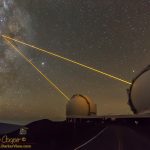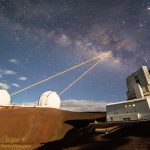I have been trying to get some good photos of both Keck lasers on the galactic center for some years. Other photographers have produced spectacular photos that have me seething with envy. Why can I not get equivalent photos? It is not like I have a lack of access. The answer is mostly bad luck and circumstance. I do work, this limits the nights I can make the attempt. On those times I have ascended the mountain to photograph I have been plagued by bad weather.

This year looked to be much the same. The night was set, I had volunteered to host several local photographers, we had film permits on-hand, an observatory vehicle reserved, all the arrangements made. The only issue? The Mauna Kea Weather Center forecast promised high clouds and fog for the night. I was bracing for yet another disappointment.
As I was hosting I headed up the mountain despite the forecast, I needed to be there as promised whatever the weather. I drove through heavy fog and pouring rain, looking at the packed camera gear in the passenger seat with a building sense of futility.
At Hale Pohaku I joined Andrew Hara and Sean Goebel, two local photographers with years of experience on the mountain. Our third companion in photography bailed on the night, not ready to dare the forecast of clouds. With two other accomplished photographers along this promised to be a chance to learn a little, even if the night proved to be a photographic bust.
We dallied in the dining room at HP talking of cameras, telescopes, and stars. We were in no hurry, clouds plagued the summit, satellite and all-sky camera imagery on our phones to be reloaded every while. Is that opening getting closer? A glimmer of hope in the 4km IR imagery from GOES-West? It was time to see for ourselves… A caravan of three vehicles climbed the summit road.
The first question was access to the domes. We wanted to photograph the telescopes, but did not want to interfere with observing and science. The clouds proved an ally here… Jason, our Keck 1 operator, informed us that the clouds were preventing any observations, we were free to photograph as we wanted, flashlights and camera LCD screens were no issue. Just give us a call on the radio if actual science might happen and we will leave the dome. Up to the NasDeck we went, the telescope looming above lit by moonlight flooding the dome. Three cameras and tripods to play. The laser was still on for a bit as the operators attempted to lock the AO system on target and failed. We moved about trying different angles. Time enough to experiment a bit, Andrew even tried some lighting with a strobe from behind the telescope.

The night was sublimely beautiful. The rising Milky Way, the setting Moon in the west, bright stars overhead, simply nothing not to like here. Better yet! The night was not very cold and there was almost no wind to chill photographers and shake the cameras. The mountain can so easily be miserable for anyone outside the warm comfort of the control rooms. Wind is the issue, a stiff, cold breeze can transform a night from pleasant to insufferable.
With the light of a setting Moon we headed west of the domes, taking advantage of the moonlight to illuminate the scenery. After a while spent near Subaru we relocated to the TMT site on the lava plateau below the telescopes, finding our way on the rough road cut through the lava in the dark.
The clouds that had threatened to ruin the night turned out to have another benefit. The occasional cloud adding an interesting atmospheric effects to the photos that would have been absent in a cloudless sky. Add the setting Moon and those clouds took on hues normally associated with sunset rather than moonset. The images appearing on the camera screens had our attention. This was simply a perfect photo session, the elements aiding rather than hindering our efforts.
The images appearing on the LCD screens had us all thrilled. This is what we came for, this is why we made the effort to ascend the mountain in the middle of the night. The bright Milky Way galaxy, the telescope domes, the brilliant yellow lasers, all the ingredients of epic photographs coming together just right.
The Keck 1 laser had been on very little of the time, we were getting lots of photos with only one beam, why? Inside, talking with the operator we find out why… The TBAD do-not-lase-the-aircraft system was showing constant transmissions preventing the laser shutter from opening. I took a quick look at the TBAD log, it looked real, not just noise or interference. We had seen this before, as had the other observatories, the military was flying some sort of aircraft over the Pōhakuloa training area below. The signal strong enough to saturate the TBAD receiver even though the aircraft was not in-beam, shuttering the laser. We think the aircraft is some sort of drone, it shows up in our cloud cameras occasionally.
As the galactic center is located low in the south, right over the military training range, we had no choice in targets to avoid the signal. The only option to TBAD is an actual person to serve as an aircraft spotter, the old way of doing things, allowing the operator to override TBAD and propagate the laser. Grabbing my lasagna from the microwave and a sports drink from the fridge I headed back outside. A few radio calls and we were back on-sky. I spent the next two hours wandering with the camera shooting another series of shots of the lasers, an activity completely compatible with keeping an eye out for aircraft around the beams.
As dawn approached and the galactic center began to set the telescopes were finally forced to change targets. Keck 2 spent a while longer hitting a target in the northern sky with the laser. This presented more photographic opportunity as the glow of dawn began to light the sky. The waxing glow of dawn filled the sky with gentle blues, a hint of purple on the clouds and white domes. The scene was still dark to the eye, long exposures with the camera revealed otherwise hidden colors. Tired and cold, but elated with the images we continued to shoot until the stars vanished in the glow. After bidding farewell to the others I stopped at the summit to watch the sun rise over the eastern horizon, a nice end to a fantastic night.


